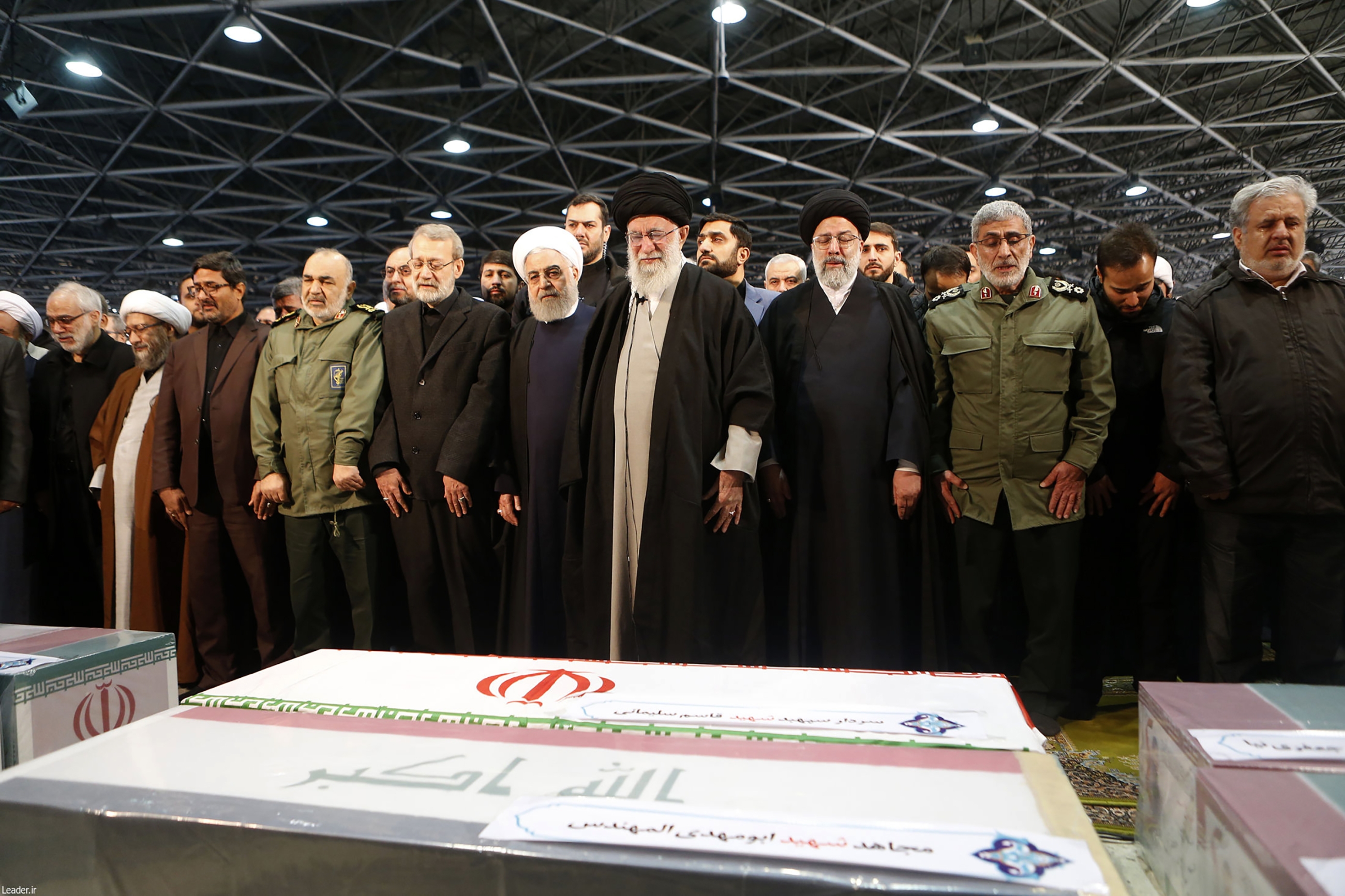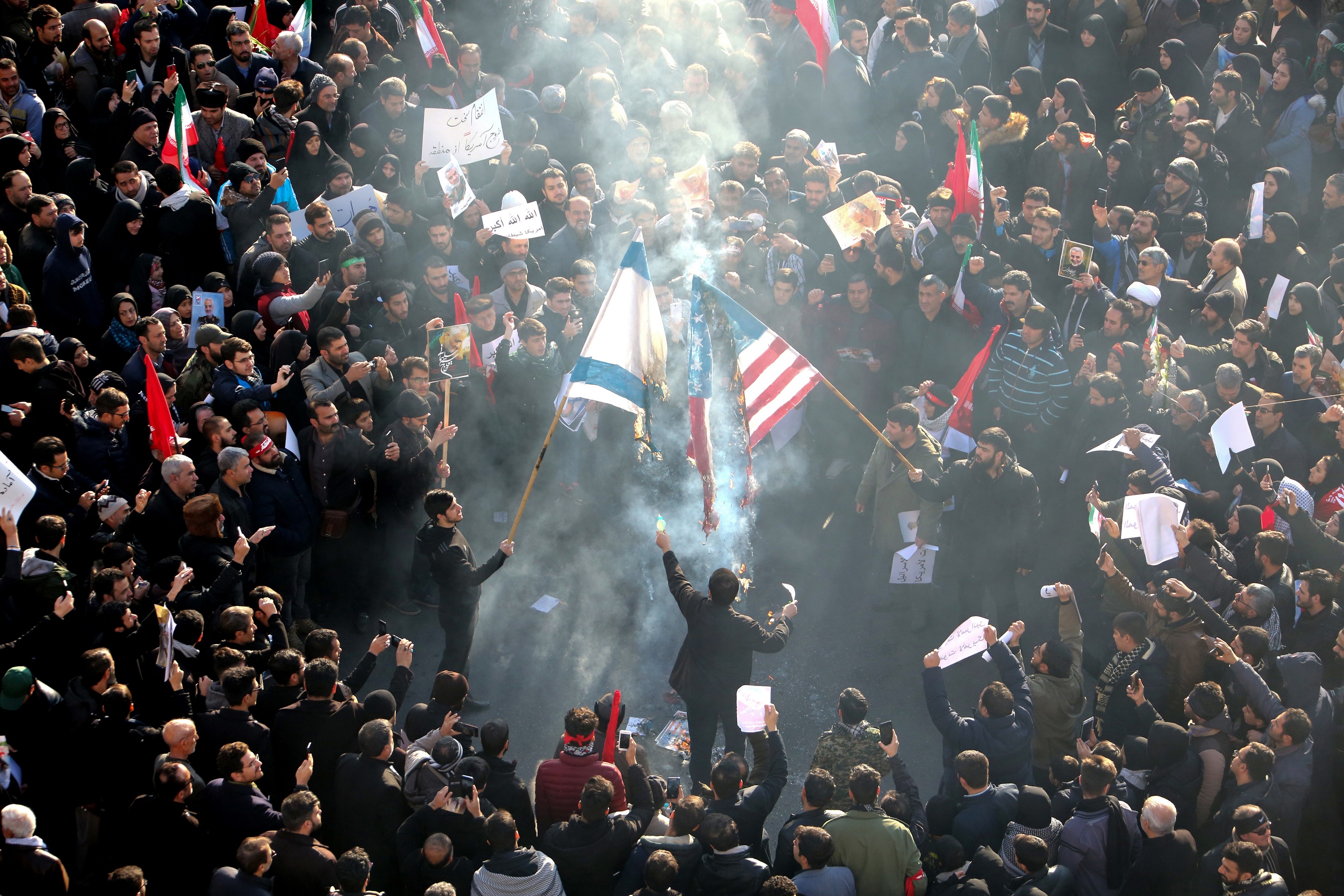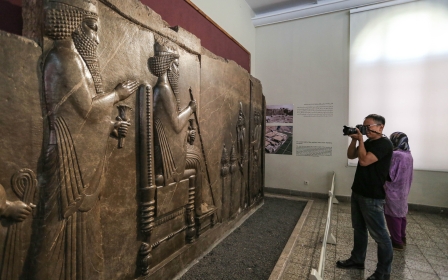Supreme Leader Khamenei weeps at Soleimani’s funeral as Iran mourns

In a rare display of emotions, Iran’s Supreme Leader Ayatollah Ali Khamenei wept while leading prayers on Monday for Quds Force commander Qassem Soleimani, who was killed in a US drone strike last week.
Hundreds of thousands of mourners packed the streets of Tehran for Soleimani’s funeral procession, chanting "Death to America".
Holding Soleimani’s portraits, anti-American placards and flags bearing the names of Shia imams, the crowd walked down the capital’s Enghelab Street towards Tehran University.
The coffins of Soleimani and Iraqi militia leader Abu Mahdi al-Muhandis, who was also killed in the strike, were passed across the heads of mourners.
Khamenei cried as he prayed over the flag-draped coffins containing the remains of Soleimani and five other "martyrs" killed in the strike.
The supreme leader was flanked by Soleimani's son, the slain general's replacement as Quds commander, Esmail Qaani, President Hassan Rouhani, Parliament Speaker Ali Larijani and the Revolutionary Guard's top commander Major General Hossein Salami.
“I woke up at 7am today, and went to the funeral of General Soleimani to express how angry I am over his assassination,” Tayebe Qasem-pour, 56, told Middle East Eye.
"In the streets, many were crying, even men, and a lot of mothers were there with their little children despite the very cold weather," she said, adding that Iranians owed Soleimani for “stopping [Islamic State] terrorists from entering Iran”.
As head of the Quds force, the arm of the Iranian Revolutionary Guard Corps (IRGC) that specialises in extraterritorial operations, Soleimani directed Iranian allies and forces in countries such as Iraq, Syria, Yemen and Lebanon.
“This man saved us, why shouldn’t we cherish him?" Alireza Sarpoulaki, a delivery man in northern Tehran, told MEE.
Sarpoulaki said most of his family attended the funeral to “say no to terror and war and to commemorate our general”.
Soleimani’s killing comes at a sensitive time in Iran in the wake of large protests that were brutally repressed by security forces, including the Revolutionary Guard.
But the sheer number of people who marched in his funeral was seen by observers as a show of national unity, which, Sarpoulaki said, the Iranian government should capitalise upon.
"I'm not a political person, but I think people have become united. I hope the establishment understands this and doesn’t do things that would destroy this unity.”
State television said the people who attended the procession numbered in the millions. The scale of the crowds in Tehran shown on television mirrored the masses that gathered in 1989 for the funeral of the founder of the Islamic Republic, Ayatollah Ruhollah Khomeini.
"People's presence in the streets today reminded me of the demonstrations before the revolution against the shah,” Ehsan Soltan-pour, a 60-year old man, told MEE.
“The crowd was huge, much like it was at those protests during the shah’s regime."
Tens of thousands of mourners also flocked to the Iranian city of Ahvaz to pay their respects to Soleimani as part of a funeral procession to mark the general's death.
Soleimani's body is expected to be buried in his hometown of Kerman on Tuesday after its march through Tehran and the holy city of Qom.
Soleimani’s daughter spoke to the masses in Tehran and said her father’s death would bring a "dark day" for the United States.
The general, who led Iran's overseas operations, was killed in a US drone strike early on Friday near Baghdad airport.
“The families of US soldiers in the Middle East will spend their days waiting for the death of their children,” Zeinab Soleimani said in her address broadcast on state television.
Trading threats
The general’s assassination heightened tensions between Tehran and Washington, with Iran promising to avenge his killing.
In response to Iran's warnings of retaliation, President Donald Trump has threatened to hit 52 Iranian sites, including cultural targets, if Tehran attacks Americans or US assets, deepening a crisis that has heightened fears of a new Middle East conflagration.
On Sunday, Trump doubled down on threats that Washington would target Iranian cultural sites in response to any retaliation by Iran.
He defended his comments aboard Air Force to reporters, and warned that the US would impose sanctions on Iraq after its parliament voted for American troops to leave the country.
His threats to target cultural sites came after he tweeted on Saturday that the US would target "52 Iranian sites" in response to any Iranian reprisals for Soleimani's death.
"They're allowed to kill our people. They're allowed to torture and maim our people. They're allowed to use roadside bombs and blow up our people. And we're not allowed to touch their cultural sites? It doesn't work that way," Trump told reporters when asked about his tweets.
Trump also contradicted comments made earlier on Sunday by US Secretary of State Mike Pompeo who denied that Trump would target cultural sites.
Targeting cultural sites with military action is considered a war crime under international law, according to a UN Security Council Resolution backed by Trump and the 1954 Hague Convention for the Protection of Cultural Property.
Saudi Arabia's foreign minister said the region faced a "very dangerous moment" and the kingdom does not want to see further escalation in tensions.
"We hope that all actors take all the steps necessary to prevent any further escalation and any provocation," Prince Faisal bin Farhan told a news briefing in Riyadh.
Saudi media reported on Monday Saudi Arabia’s Deputy Defense Minister Khalid bin Salman was to be sent to Washington in the coming days to urge restraint.
Meanwhile Turkey said it would work to stop Iraq becoming a "conflict zone for other, third-party countries".
Sanctions on Baghdad
Trump also threatened to impose sanctions on Iraq after its parliament called for the US and other foreign troops to leave the country.
“We have a very extraordinarily expensive air base that’s there. It cost billions of dollars to build, long before my time. We’re not leaving unless they pay us back for it,” Trump told reporters.
He added: “We will charge them sanctions like they’ve never seen before ever. It’ll make Iranian sanctions look somewhat tame.”
The resolution passed by the Iraqi parliament on Sunday however is not binding but has seen support from Iraqi Prime Minister Adel Abdul Mahdi.
Mahdi told the Iraqi parliament that Trump had called him hours before Soleimani's death and requested that Iraq help mediate with Iran after the US embassy was attacked.
Nuclear tensions
Adding to tensions, Tehran said it was further rolling back its commitments to a 2015 nuclear deal with six powers, which the United States withdrew from in 2018, but would continue to cooperate with the UN nuclear watchdog.
The International Atomic Energy Agency policing the agreement said it would instantly report any developments to its member states.
Germany said Iran's move to abandon limitations on enriching uranium could end the pact.
"What Iran has announced is no longer in accordance with the agreement, so we will sit down today with France and Britain to decide on that - how we respond to that this week," German Foreign Minister Heiko Maas said.
Russia's foreign ministry meanwhile said that it saw no threat of nuclear weapons proliferation after Iran’s decision and Moscow remains fully committed to the deal.
Tehran has started scaling back its commitments to the agreement step by step since the US pulled out of the deal and imposed harsh economic sanctions on Iran.
Washington described its policy as "maximum pressure" and said it wanted to drive down Iranian oil exports - the main source of government revenues - to zero.
Iran's economy has been in freefall as the currency has plunged in value.
Reuters and AFP contributed to this report.
Middle East Eye propose une couverture et une analyse indépendantes et incomparables du Moyen-Orient, de l’Afrique du Nord et d’autres régions du monde. Pour en savoir plus sur la reprise de ce contenu et les frais qui s’appliquent, veuillez remplir ce formulaire [en anglais]. Pour en savoir plus sur MEE, cliquez ici [en anglais].







